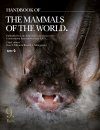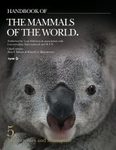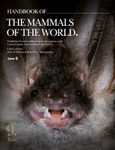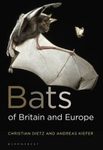About this book
Volume 9 completes the Handbook of Mammals of the World series, and it deals with the bats, order Chiroptera.
Read our interview with the series creators
Our knowledge of bats has exploded in the past two decades, and all of that information is reflected in this volume. The number of recognized species has increased by more than 400 during that time and is still growing. Bats occupy almost every habitat on six continents and their ecology is incredibly diverse. Pollinators and seed dispersers for thousands of species of plants, bats are critical for the maintenance of tropical ecosystems.
As always, the text includes up-to-date information on every species, and each one is carefully illustrated. The family accounts include color photographs documenting a variety of behaviors of these interesting mammals. For this volume, the approximately 8100 references are included on a CD-ROM attached to the inside of the back cover.
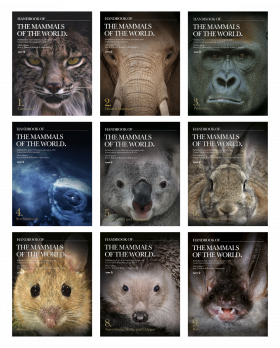
Volumes 1-9 can also be bought together.
Contents
Order CHIROPTERA
Family Pteropodidae (Old World Fruit Bats) / Norberto Giannini, Connor Burgin, Victor van Cackenberge, Susan Tsang, Stephan Hintsche, Tyrone Lavery, Frank Bonaccorso, Francisca Almeida & Brian O’Toole
Family Rhinopomatidae (Mouse-tailed Bats) / Ivan Horáček
Family Craseonycteridae (Hog-nosed Bat) / Tigga Kingston & Pipat Soisook
Family Megadermatidae (False-vampire Bats) / Charles M. Francis
Family Rhinonycteridae (Trident Bats) / Petr Benda
Family Hipposideridae (Old World Leaf-nosed Bats) / Ara Monadjem, Pipat Soisook, Vu Dinh Thong & Tigga Kingston
Family Rhinolophidae (Horseshoe Bats) / Gábor Csorba, Anthony Hutson, Steve Rossiter & Connor Burgin
Family Emballonuridae (Sheath-tailed Bats) / Frank Bonaccorso
Family Nycteridae (Slit-faced Bats) / Ara Monadjem
Family Myzopodidae (Madagascar Sucker-footed Bats) / Steve Goodman
Family Mystacinidae (New Zealand Short-tailed Bats) / Cory Toth
Family Noctilionidae (Bulldog Bats) / Rodrigo Medellín
Family Furipteridae (Smoky Bat and Thumbless Bat) / Joaquín Arroyo-Cabrales
Family Thyropteridae (Disk-winged Bats) / Thomas Lee, Jr.
Family Mormoopidae (Ghost-faced Bats, Naked-backed Bats and Mustached Bats) / Ana D’Oliveira Pavan
Family Phyllostomidae (New World Leaf-nosed Bats) / Sergio Solari, Rodrigo Medellín, Bernal Rodríguez-Herrera, Valeria da Cunha Tavares, Guilherme Garbino, M. Alejandra Camacho, Diego Tirira Saá, Burton Lim, Joaquín Arroyo-Cabrales, Armando Rodríguez-Durán, Elizabeth Dumont, Santiago Burneo, Luis F. Aguirre Urioste, Marco Tschapka & Deborah Espinosa
Family Natalidae (Funnel-eared Bats) / Adrián Tejedor
Family Molossidae (Free-tailed Bats) / Peter Taylor, Burton Lim, Michael Pennay, Pipat Soisook, Tigga Kingston, Livia Loureiro & Ligiane Moras
Family Miniopteridae (Long-fingered Bats) / Javier Juste & Carlos Ibáñez
Family Cistugidae (Wing-gland Bats) / Manuel Ruedi
Family Vespertilionidae (Vesper Bats) / Ricardo Moratelli, Connor Burgin, Vinícius Cláudio, Roberto Novaes, Adrià López-Baucells & Rudolf Haslauert
Customer Reviews (2)
-
The Bees (Bats) knees
By
Colin
11 Nov 2019
Written for Hardback
Well, if ever you had to buy just one book on bats, this is it. Just about the most complete and definitive tome you'll need. A book that contains all the known species (to date) cannot have everything that everyone is looking for but it covers a lot. 10/10.
8 of 8 found this helpful
-
Was this helpful to you? Yes No
-
Key reference to the 21 families of bats
By
Gehan de Silva Wijeyeratne
3 May 2020
Written for Hardback
The final volume in the Handbook of the Mammals of the World marks the end of an epic scientific journey which has seen a multidisciplinary team of administrators, editors, fundraisers, scientists, artists, designers and a host of other skilled professionals document all of the living mammals on our planet in a series of books where every mammal is illustrated for the first time with succinct information provided on every species together with a distribution map.
The final volume follows (well nearly) the standard format for the series. A few preliminaries are followed by expansive family introductions which are grouped under standard categories including Systematics, Morphological Aspects, Habitat, General Habits, Communication, Food and Feeding, Breeding, Movements, Home Range and Social Organisation, Relationships with Humans and finally Status and Conservation. These sections are interspersed with stunning images of a generous size afforded by the larger encyclopaedia size of the pages. Some images occupy a full page combining a coffee-table presentational format to a book underpinned by solid science. One surprise with this volume is that the index and the references are on a CD and can also be downloaded free from the Lynx Edicions website. The latter is essential because technology has evolved and people demand slimmer and lighter laptops and CD readers are no longer included as standard. In the very first page of the introduction this departure from other volumes is explained. The rapid increase in the number of species to over 1,400 species had resulted in a book which would have exceeded 1,200 pages; larger than the size that could have been bound into a single volume.
I suspect the references of 102 pages and the index of 23 pages being available only as PDFs will produce a mixed reaction. Of course in a book, it is nice to have them all in the book. But there is a huge advantage with the PDFs. It is very easy now to search the index and pdf on your laptop and also very easy to copy over any references if you are working on an article and paper. I for one would be happy if the references for all of the HMW series were to be made available in the future as searchable PDFs on their website
With all of the volumes in the HMW, the species accounts are very much in the vein of something you refer to, but the extensive family accounts are pages that you could happily dip into at random and find the content utterly absorbing if you have an interest in mammals. The family accounts in the other volumes were almost always in accessible language. However, with this volume some of the text is necessarily technical when matters such as vocal frequencies, dentition and bone structure are discussed in separating genera. No less than 52 authors are responsible for the text and a team of seven artists have painted the plates to create definitive reference work under the chief editorship of two of the most respected and published mammalogists in the world. As always, the images are stunning, whether it is a fruit bat flying and carrying one of its young or a day roost of bats under a branch looking like some strange tree fungi.
When I first wrote and photographed a guide to the mammals of Sri Lanka a few decades ago, fruit bats were in the Megachiroptera and the insectivorous bats were in the Microchiroptera suborders. The long-established classical taxonomy has been overturned by molecular phylogenetics showing that the megabats are nested within the microbats. In the first three pages of introduction there is an explanation of how the 21 families are now grouped with seven families in the suborder Yinpterochiroptera and the remaining 14 in the suborder Yangochiroptera. There is also a thumbnail summary of the families in the first three pages. I would have liked to have seen something like a stylised phylogenetic diagram to illustrate the relationship between the families. Although this is absent, nevertheless, the more taxonomically complex families such as Old Word Fruit Bats (family Pteropididae) and Vesper Bats (family Vespertilionidae) for example, have simple diagrams to show how the families break down into subfamilies and tribes. The Old World Fruit Bats, for example, comprise eight subfamilies with the subfamily Rousettinae having seven tribes.
For some people, the taxonomic details might be just technical noise and irrelevant to enjoying these wonderful mammals which show so much variety (21 families!). But for others like me, knowing some of these levels of taxonomic groupings makes it easier to have a ‘mental filing system’ to deal with a large number of species. Quite often (but not always) subfamilies and tribes have a geographic node as colonising mammals speciated. For someone like me who has a home in two continents, it is always interesting to understand which families are found where. In Asia, I would go up to the rooftop with my youngest daughter when she was a little child and watch the sky pepper with dark dots at dusk as a swarm of Indian Flying Foxes left a city park and flew over our house with purposeful wingbeats. In the UK the fruit bats are absent, but we join the bat walks at the London Wetland Centre to see and hear on bat detectors, species that represent families found in both Asia and Europe. As with many birders who have a fascination with taxonomic matters, I always find the Systematics section of the family accounts very interesting. A study of how we have grouped families is also a study of how science has changed.
By comprehensively documenting and illustrating every species of mammal in the world, the HMW sets a new baseline of reference for researchers. It is a milestone, but not the end of a project to document mammals; it marks yet another beginning since there is so much more to learn in a world where new and sometimes even large mammals are still found hidden in plain sight.
5 of 5 found this helpful
-
Was this helpful to you? Yes No
Biography
Editors:
Dr D. E. Wilson: Curator Emeritus, National Museum of Natural History, Smithsonian Institution, Washington, DC, USA.
Dr R. A. Mittermeier: Chief Conservation Officer, Global Wildlife Conservation; Honorary Member, International Union for Conservation of Nature (IUCN); and Chair, IUCN/SSC Primate Specialist Group, USA.
Artists:
Ilian Velikov (b. Bulgaria, 1985) is a wildlife artist who has had a strong interest in the natural world since an early age. He studied and worked in the animation industry where he mastered the digital drawing and painting techniques which he now uses in his illustrations. Besides drawing wildlife he is often out in the field observing it and has assisted in a number of mostly herpetological studies. He illustrated the Field Guide to the Amphibians & Reptiles of Britain and Europe and Europe by J. Speybroeck et al. and since 2018 has worked with Lynx Edicions on a variety of projects including Ocells de Catalunya, País Valencià i Balears, Lynx and BirdLife International Field Guides and the Handbook of the Mammals of the World.
Àlex Mascarell Llosa (b. Barcelona, 1978) is a naturalist, designer and illustrator who works mainly on educational materials and has a special interest in ornithology. In addition to his work designing layouts for a range of teaching materials, he is an animal illustrator. Passionate about birds, he works regularly at Barcelona Zoo, collaborating with many organizations and institutions in the design of materials and the production of original illustrations. He has participated in the Dictionari de las Aus en Català, which collates the Catalan nomenclature of all the bird species of the world, and he works pro bono on drawing projects for other institutions dedicated to the defense of the natural world, both locally and internationally. He has worked on Volume 2 of the Illustrated Checklist of the Birds of the World and on the Birds of Thailand and the Birds of Vietnam from the Lynx and Birdlife International Field Guides Collection.
Lluís Sogorb (b. Monòver, 1965) is a self-taught painter and illustrator. His abilities and interest in the natural world led him to the illustration and painting of nature. Although he began with traditional techniques like graphite, watercolour, acrylic and oil paint, as soon as digital techniques became available he became interested in them and currently creates almost all his illustrations in this way. His illustrations have appeared in numerous publications and he has taken part in various educational projects centred on the environment and conservation. In recent times he has taken part in various projects involving ornithological tourism, as well as frequently collaborating with different publishers. He has participated in A New European Breeding Bird Atlas, currently in preparation. In 2013 he won the first "Concurso de Ilustración de la Naturaleza" (Illustration prize) organized by the "Sociedad Gaditana de Historia Natural" for his image of a Northern Bald Ibis. In 2017 he was awarded a prize in the Painting Animals in the Wild category of the "XI Golden Turtle Wildlife Festival" (Moscow, Russia) for his painting The Guardian of the Mountain.
Blanca Martí de Ahumada is a scientific and nature illustrator. She graduated from the University of Barcelona in Art History, and is a naturalist by vocation. She specializes in scientific and children’s illustration at the Barcelona school "Escola de la Dona de la Diputació" and imparts training courses at the Universities of Valencia and Barcelona. Her illustrations have appeared in various national and international publications: scientific and educational books in Catalonia, Costa Rica, Brazil and Nicaragua, and also on posters for natural parks: the "Parc Natural del Montnegre i El Corredor", "Parc del Foix" in metropolitan Barcelona and the Dindefello Reserve in Senegal, among others. She has also illustrated teaching materials for nature resorts and animal reserves such as "Molló Parc" or "Centre d’Estudi i divulgació del Llop Signatus". She is currently working on projects for the publisher "Zona Tropical" of Costa Rica and participating in the volume Bats from the collection Handbook of the Mammals of the World.
Faansie Peacock (b. Pretoria, 1982) is a South African ornithologist, author and artist with a passion for biodiversity and, specifically, sharing the natural world with those around him. Through his various publications, both scientific and popular, Peacock bridges the gap between the academic and public spheres in the hope that increased awareness and affinity to nature ultimately leads to conservation. He specialises in digital painting techniques, which allows him to produce unprecedented numbers of illustrations of exceptional accuracy and quality. Working from his own field sketches together with museum skins and reference photographs, Peacock has authored and illustrated specialist guides on LBJs (larks, pipits, cisticolas, warblers etc.), waders (shorebirds), and threatened species. In line with his current mindset as a father of two young boys, his latest book is a complete field guide to 722 species of South African birds, aimed specifically at children. In addition to books, he has done natural history illustration, design and layout work in a wide variety of formats, from business cards to billboards.
Jesús Rodríguez-Osorio Martín (b. Madrid, 1965) is a self taught artist. From an early age a strong sense of vocation drew him to the natural world and he used illustration as a way of satisfying his zoological curiosity. Over the years he refined his techniques and in the 1980s published a number of illustrations in Quercus magazine. He illustrated an entire volume of the prestigious Fauna Ibérica (Volume 44: Coleoptera: Hydraenidae). He spent years combining the photography of wild animals with illustration, but with the arrival of digital illustration techniques he opted for these. He is one of the illustrators of Volume 9 of the Handbook of the Mammals of the World.






